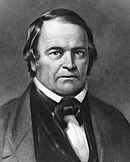
Back Sewendedagadventisme AF الكنيسة السبتية Arabic ادفنتيست ARZ Yeddinci günün adventistləri AZ Simbahan kan Adbentista kan Ikapitong Aldaw BCL Църква на адвентистите от седмия ден Bulgarian সেভেন্থ ডে এডভান্টিস্ট মণ্ডলী Bengali/Bangla Església Adventista del Setè Dia Catalan Adventisté sedmého dne Czech Syvende Dags Adventistkirken Danish
This article may rely excessively on sources too closely associated with the subject, potentially preventing the article from being verifiable and neutral. (September 2022) |
| Seventh-day Adventist Church | |
|---|---|
 The Seventh-day Adventist logo | |
| Classification | Protestant |
| Orientation | Adventist |
| Theology | Seventh-day Adventist theology |
| Polity | Presbyterian/Episcopal |
| President | Ted N. C. Wilson |
| Region | Worldwide |
| Founder | |
| Origin | May 21, 1863 Battle Creek, Michigan, U.S. |
| Branched from | Millerites |
| Separations |
|
| Congregations | |
| Members | 22,234,406[4] |
| Pastors | 20,924[4] |
| Aid organization | Adventist Development and Relief Agency |
| Hospitals | 229[4] |
| Nursing homes | 129[4] |
| Primary schools | 6,623[4] |
| Secondary schools | 2,640[4] |
| Tertiary institutions | 118[4] |
| Other name(s) | Adventist church, SDA (informal) |
| Official website | adventist |
| Part of a series on |
| Seventh-day Adventist Church |
|---|
 |
| Adventism |
| Part of a series on |
| Adventism |
|---|
 |
|
|
The Seventh-day Adventist Church (SDA)[5] is an Adventist Protestant Christian denomination[6][7] which is distinguished by its observance of Saturday,[8] the seventh day of the week in the Christian (Gregorian) and the Hebrew calendar, as the Sabbath,[7] its emphasis on the imminent Second Coming (advent) of Jesus Christ, and its annihilationist soteriology. The denomination grew out of the Millerite movement in the United States during the mid-19th century, and it was formally established in 1863.[9][10] Among its co-founders was Ellen G. White, whose extensive writings are still held in high regard by the church.[11]
Much of the theology of the Seventh-day Adventist Church corresponds to common evangelical Christian teachings, such as the Trinity and the infallibility of Scripture. Distinctive eschatological teachings include the unconscious state of the dead and the doctrine of an investigative judgment. The church emphasizes diet and health, including adhering to Jewish dietary law, advocating vegetarianism, and its holistic view of human nature—i.e., that the body, soul, and spirit form one inseparable entity.[12] The church holds the belief that "God created the universe, and in a recent six-day creation made the heavens and the earth, the sea, and all that is in them, and rested on the seventh day." Marriage is defined as a lifelong union between a man and a woman. The second coming of Christ and resurrection of the dead are among official beliefs.[13]
The world church is governed by a General Conference of Seventh-day Adventists, with smaller regions administered by divisions, unions, local conferences, and local missions. The Seventh-day Adventist Church is as of 2016[update] "one of the fastest-growing and most widespread churches worldwide",[7] with a worldwide baptized membership of over 22 million people. As of May 2007[update], it was the twelfth-largest Protestant religious body in the world and the sixth-largest highly international religious body. It is ethnically and culturally diverse and maintains a missionary presence in over 215 countries and territories.[14][15] The church operates over 7,500 schools including over 100 post-secondary institutions, numerous hospitals, and publishing houses worldwide, a humanitarian aid organization known as the Adventist Development and Relief Agency (ADRA) and tax-exempt businesses such as Sanitarium,[16] the proceeds of which contribute to the church's charitable and religious activities.
- ^ a b c Gorman, Tom; Lightblau, Eric (August 13, 1998). "Currents of Change Roil Seventh-Day Adventists". Los Angeles Times. Retrieved July 16, 2024.
- ^ a b "Carson opens up about his membership in Seventh-day Adventist Adventist Church". PBS News Hour. October 31, 2015. Retrieved July 16, 2024.
- ^ Taylor, Jessica (October 27, 2015). "All Your Questions About Seventh-Day Adventism And Ben Carson Answered". National Public Radio. Retrieved July 16, 2024.
- ^ a b c d e f g h i "Seventh-Day Adventists World Church Statistics 2022" (PDF). March 1, 2022.
- ^ King, Tamiya (September 28, 2017). "Seventh Day Adventist Wedding Ceremony". Oureverydaylife. Retrieved August 19, 2023.
- ^ Queen, Edward L.; Prothero, Stephen R.; Shattuck, Gardiner H. (2009). "Seventh-day Adventist Church". Encyclopedia of American religious history. Vol. 3 (3rd ed.). New York: Infobase Publishing. p. 913. ISBN 978-0-8160-6660-5.
- ^ a b c Feichtinger, Christian (2016). "Seventh-day Adventists: An Apocalyptic Christian Movement in Search for Identity". In Hunt, Stephen J. (ed.). Handbook of Global Contemporary Christianity: Movements, Institutions, and Allegiance. Brill Handbooks on Contemporary Religion. Vol. 12. Leiden: Brill Publishers. pp. 382–401. doi:10.1163/9789004310780_019. ISBN 978-90-04-26539-4. ISSN 1874-6691.
- ^ Lipka, Michael (November 3, 2015). "A closer look at Seventh-day Adventists in America". Pew Research Center. Retrieved September 7, 2022.
- ^ "News In Brief". The Washington Post. July 8, 1995. Retrieved July 18, 2023.
- ^ Tevington, Andrew. "Denominations have differing views about religious holidays". The Oklahoman. Retrieved June 24, 2024.
- ^ Ronald L. Numbers, Prophetess of Health: A Study of Ellen G. White (3rd ed. 2008) pp. xxiii–xxiv.
- ^ Arnoldi, Tina (March 13, 2020). "The Holistic Approach to Care in the Adventist Church". Theravive.
- ^ https://www.adventist.org/beliefs/ [bare URL]
- ^ "Seventh-day Adventist World Church Statistics". Office of Archives and Statistics, General Conference of Seventh-day Adventists. December 2009. Archived from the original on September 19, 2012. Retrieved September 4, 2011.
- ^ "Statistical report. Annual council of the General Conference Committee, October 9–14, 2009" (PDF). June 30, 2009. Archived from the original (PDF) on April 15, 2010. Retrieved March 23, 2010.
- ^ "Lifting the lid on Sanitarium – Business News". NZ Herald. June 29, 2012. Retrieved October 14, 2022.